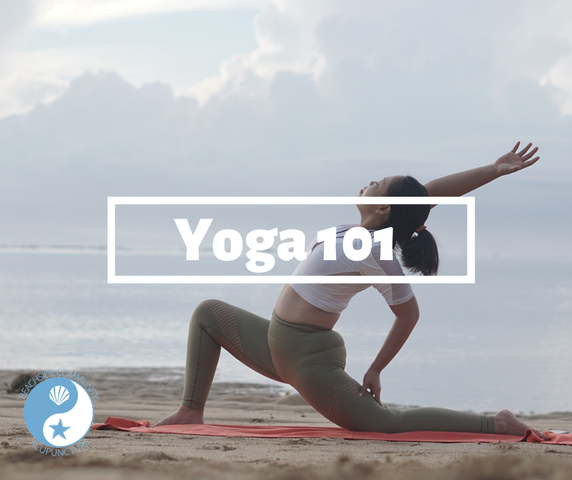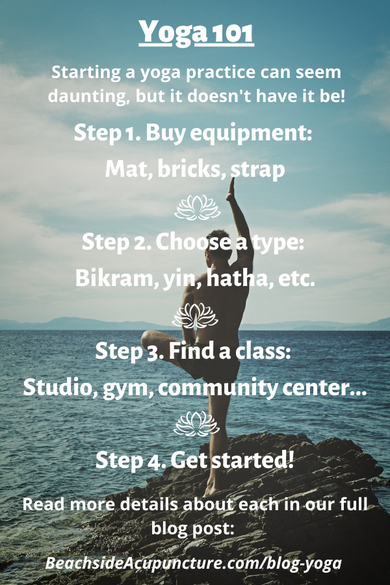
This post contains affiliate links, meaning Beachside Community Acupuncture PLLC may receive a small commission for purchases made through certain links at no additional cost to you. (In other words, you support us in a small way when you buy the products that we highly recommend and would use ourselves!) Click here to view our full disclosure policy.
While Traditional Chinese Medicine includes mindful movement in the forms of tai chi and qigong, the sister practice of the ancient Indian medicine of Ayurveda is yoga. Although practiced for thousands of years, yoga has only become a very popular way of stretching, meditating, and exercising in the past few decades. If you're interested in trying it but feel intimidated, this blog post is for you!
Equipment
You can technically practice yoga anywhere with no special props other than your body, but these may be helpful:
- Mat: While cheap mats are available in a variety of stores, they tend to wear thin and come apart very quickly. This isn't good for your yoga practice, the planet, or your wallet in the long-term. Manduka yoga mats are more expensive upfront, but their PRO and PROlite lines come with a lifetime warranty.
- Blocks: When you're first starting out, yoga blocks provide stability until your hands are able reach the ground in bending poses.
- Strap: Yoga straps are sturdy, not like the elastic bands used in resistance training, and they usually have buckle so that you can loop an end around your foot if needed. They are great for poses that require grasping your feet with straight legs or connecting your hands together behind your back.
The Basics of Yoga
Yoga often makes people think of contortionist movements, but any yoga instructor will tell you that the most important aspect of your practice is not how far you can get in a pose but rather your breathing. When you first start out, your focus should be on your inhales and exhales instead of pushing your body to stretch. If you breathe well, the stretching will come naturally.
Patience is key when you first start out. Everyone wants to do the awe-inspiring advanced poses, but jumping right into them will most likely lead to an injury. Listen to your body as you move through the basics and add more challenging modifications once it feels like your body can handle them. Having an instructor can really help in this department! Even a simple pose involves specific body placements - for instance squaring your hips or having your toes face a certain direction - and a qualified yoga teacher can make micro-adjustments to your position. If you'd rather start your practice at home following videos before working your way up to a class, be very mindful of your body's orientation and look online for tips on the proper posture for a particular pose if you feel like something's not quite right.
Types of Yoga
There are many ways to practice yoga, so you are almost guaranteed to find at least one that you like! We recommend trying a variety, starting with a gentler type of yoga if you're a beginner and moving up from there. Here are a few examples of what you may come across:
- Yin yoga: Yin yoga involves holding poses for longer periods of time and is usually composed of passive floor movements. This is possibly the most restful and meditative yoga practice, focusing on stretching over power.
- Chair yoga: Also gentle, chair yoga is especially great for those who have trouble lying down, balance issues, or difficulty getting up and down from the floor.
- Hatha yoga: Most yoga classes that don't specify a type would be considered hatha yoga. Still gentle, this yoga incorporates breathing while moving through and holding poses, some of which may be more challenging. The instructor chooses the poses in these classes, unlike other types that have a regimented flow.
- Vinyasa yoga: Vinyasa yoga classes can be more fast-paced, as each pose is tied to an inhale or exhale. The intensity may range from easy to challenging, and the instructor usually has free rein to direct students into a variety of poses.
- Ashtanga yoga: More structured than the previous types, ashtanga yoga follows a set sequence of poses and may be more physically demanding.
- Bikram yoga: Also following a set sequence, the biggest distinguishing factor of Bikram yoga is its environment. The room in which it is practiced will be 105 degrees and have 40% humidity.
- Power yoga: Not officially yoga, power yoga includes yoga poses but feels more like an exercise class because it's more concerned with building strength than meditating.
Where to Find Yoga Classes
Yoga's popularity has boomed over the years, and many athletes cross-train with yoga to bring flexibility and balance into their exercise routines. Because of this, yoga classes are almost everywhere! Here are a few places to find them:
- Yoga studios: The most obvious is a "gym" dedicated solely to yoga. Studios tend to be expensive but will often have the highest quality of classes because yoga is their only focus. You may need to join a studio if you're looking for a very specific type of yoga; for instance, Bikram requires a room at a higher temperature and is therefore less often seen at the other options below. Some yogis also prefer the authenticity of a yoga studio or like that its yoga classes don't have to compete with outside noise like they might at a traditional gym or outdoor space. However, if you're just testing the waters of yoga, it might be a good idea to start with a less expensive option or purchase studio classes individually before committing to a full membership.
- Gyms: If you already belong to a gym, check its class schedule because chances are it includes yoga. A gym may have fewer options when it comes to yoga types, but you can still find great classes. Also, the yoga instructor makes all the difference, so try classes led by different teachers until you find one that you enjoy.
- Community centers: Similar to gyms, community centers may not offer a wide range of yoga, but you may still find fun and challenging classes if the community center employs experienced teachers.
- Parks, beaches, and other outdoor areas: Nothing beats being active in the sunshine, and yoga can be even more special when it's practiced outside. You may come across an outdoor yoga class accidentally, but to be more intentional about finding one, look online. Cities - or even smaller areas like parks or subdivisions - often have events calendars, and websites like Meetup almost always have at least one yoga group. You may get less attention from your instructor at a large outdoor class, but they're usually geared more towards beginner yogis.

A famous quote about yoga goes, "If you practice yoga once a week, you will change your mind. If you practice yoga twice a week, you will change your body. If you practice yoga every day, you will change your life.” Yoga has a host of health benefits - everything from cardiovascular system support to increased energy to stress reduction - and a consistent practice means regular deep breathing, meditation, stretching, balance work, and strength training. Build a yoga practice into your regular health routine, and you'll set yourself up for reduced injuries in your other exercise endeavors and even in your day-to-day life. Why not get started this week?

Kathleen Ketola is a Licensed Acupuncturist and the owner of Beachside Community Acupuncture. She loves providing affordable acupuncture to the residents of McKinney, Texas, and surrounding cities like Prosper, Frisco, and Plano, but she also enjoys educating the general public on how acupuncture and Traditional Chinese Medicine (TCM) can treat everything from pain to infertility to stress and beyond. Click "Book Now" at the top of this page to book an appointment or feel free to contact her at (214) 417-2260.









